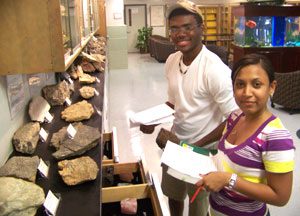

Atiger shark jaw from Key Largo, bottom sediments from the Antarctic and a whale’s tooth from Chesapeake Bay — wherever former Miami Dade College professor Loren D. Wicks went, he and his wife traveled with a hammer and pick, ready to excavate and collect samples.
Wicks passed away in 1987, but many of his archeological treasures are found today at the Earth Science Museum and Demonstration Center, better known as “Kendall Rocks,” located in Building Five of the Miami Dade College Kendall campus.
Diane McKinney, an associate instructor who oversees the museum, was an art major attending classes at the Kendall Campus more than 30 years ago when inspired to study geology after taking classes with Wicks.
“Professor Wicks used to say, ‘Wherever you go, make sure you bring back rocks,’” McKinney recalled. “He was my mentor and made me want to be a scientist.”
Before Room 5130 became home to the Earth Science Museum in 2004, the space had accommodated a cafeteria, a bookstore, art, and was once considered for a classroom. While the lighting was judged too limited to serve as a classroom, the approximate 1,200-square-foot area has proven ideal to showcase soil and sand samples, skulls, rocks, minerals, marine fossils, precious stones, pottery, turtle bones, and animal jaws, among thousands of other items.
“Overall, we have about 5,000 items on display and another 5,000 stored,” said McKinney, who today holds degrees in geology from both FSU and FIU and has watched over Wicks’ collection since 2004 when the museum was opened as a memorial to him.
Visitors enter the Rocks Museum between two 250-gallon tanks, displaying colorful tropical fresh and saltwater fish, opening onto wall displays of hundreds of catalogued rock specimens, fossils and fluorescent rocks that glow in the dark under ultra-violet “black” lighting.
“I wanted to create a place where you could come in and touch everything. It’s the best way to learn, up close and personal,” said McKinney, who gives tours and demonstrations to groups from local schools, teaching how to make fossil replicas and recreating archeological digs. Children in the college’s “Wild Things Happen” and Science/Nature summer camps are spending time in the museum as a fun and educational component.
“I’ll bring the kids here and they get to run around and touch all the rocks; it’s something neat for them to do,” said Max Rodriguez, a Kendall Campus summer camps coordinator “The museum has really become much more than I ever dreamed,” McKinney added. “We have hundreds of visitors, including dignitaries from China. I think Loren would be smiling, wherever he is now.”





